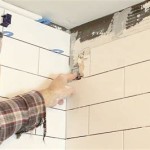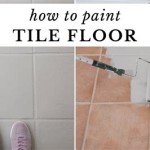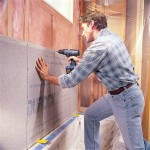How To Remove Floor Tiles From Concrete Slab Without Damaging It
Removing existing floor tiles from a concrete slab requires careful planning and execution to prevent damage to the underlying concrete. A damaged slab can lead to costly repairs, potentially requiring resurfacing or even complete replacement before new flooring can be installed. This article outlines a methodical approach to tile removal, emphasizing techniques that minimize the risk of concrete damage.
The success of tile removal hinges on understanding the factors that contribute to a strong bond between the tile and the concrete. These factors include the type of adhesive used, the age of the installation, and the porosity of both the tile and the concrete. Newer installations often present a greater challenge due to the improved bonding capabilities of modern adhesives. Similarly, highly porous tiles and concrete create a more robust mechanical bond, making separation more difficult.
Prior to beginning the removal process, a thorough inspection of the tiled area is essential. This involves assessing the condition of the grout lines, noting any existing cracks or loose tiles, and identifying the type of tile and grout used. Understanding these characteristics will help in selecting the appropriate tools and techniques for removal.
Safety is paramount during tile removal. Eye protection, gloves, and a dust mask are crucial to protect against flying debris and potential exposure to harmful substances in the tile adhesive or grout. Consider wearing knee pads or using a kneeling pad for comfort, especially when dealing with large areas. Proper ventilation is also important, particularly when using power tools or chemical solvents.
Before committing to a full-scale removal, it is advisable to test a small, inconspicuous area. This allows for an assessment of the effectiveness of the chosen method and provides an opportunity to refine the technique before proceeding with the entire project. Start with an area near a wall or in a closet, where minor damage is less noticeable.
Preparation and Tool Selection
Adequate preparation is the first crucial step in minimizing concrete damage. This involves clearing the area of all furniture, appliances, and other obstructions. Cover any nearby surfaces that need protection from dust and debris, such as walls and cabinets. A plastic drop cloth secured with painter's tape is an effective solution for this purpose.
Choosing the right tools is critical for efficient and damage-free tile removal. The specific tools required will depend on the type of tile, the strength of the adhesive bond, and the size of the area to be cleared. However, some essential tools are common to most tile removal projects.
A hammer and chisel are fundamental tools for manually breaking and prying up tiles. A variety of chisel sizes and shapes are available; a wider chisel is useful for lifting larger pieces of tile, while a narrower chisel is better for working in tight spaces or along grout lines. Look for chisels with hand guards to protect your hands from accidental hammer strikes.
A thin-set scraper, also known as a floor scraper, is designed to remove residual thin-set mortar from the concrete slab after the tiles have been removed. These scrapers typically feature a long handle and a replaceable blade, allowing for efficient scraping while minimizing strain on the back. Choose a scraper with a sturdy blade and a comfortable handle.
Grout removal tools are essential for removing grout before attempting to lift the tiles. Options include manual grout saws, power grout removal tools, and chemical grout softeners. Manual grout saws are inexpensive and effective for small areas, while power tools can significantly speed up the process for larger projects. Chemical grout softeners can help to loosen the grout, making it easier to remove with other tools.
For larger projects or tiles that are particularly difficult to remove, a power chisel or demolition hammer may be necessary. These tools deliver rapid, powerful impacts that can quickly break the bond between the tile and the concrete. However, they also carry a higher risk of damaging the concrete slab, so they should be used with caution and only when other methods have proven ineffective. Start on a spot you are okay with damaging to access whether or not the concrete is going to be damaged.
A shop vacuum is indispensable for keeping the work area clean and free of dust and debris. Regular vacuuming will improve visibility and prevent the spread of dust to other parts of the building. A shop vacuum with a HEPA filter is recommended to capture fine dust particles and minimize air pollution.
Techniques for Tile Removal
The core of successful tile removal lies in employing techniques that systematically weaken the bond between the tile and the concrete without applying excessive force that could damage the slab. Start by carefully removing the grout around each tile. This can be achieved using a grout saw, a power grout removal tool, or a chemical grout softener. Removing as much grout as possible will reduce the resistance when attempting to lift the tiles.
After removing the grout, use a hammer and chisel to gently tap around the edges of the tile. The goal is to create small cracks in the adhesive bond, gradually loosening the tile. Avoid striking the chisel directly on the tile surface, as this can cause the tile to shatter and create sharp fragments. Instead, position the chisel at a low angle and tap it firmly but gently with the hammer.
Once you have loosened the tile around the edges, attempt to pry it up using the chisel. Insert the chisel under one edge of the tile and gently rock it back and forth. If the tile resists, continue tapping around the edges to further weaken the bond. Work slowly and methodically, applying steady pressure rather than sudden force. If resistance is high, stop and evaluate if you are going to keep going at the risk of damaging the concrete slab.
For tiles that are particularly stubborn, consider using a heat gun or a steamer to soften the adhesive. Applying heat or steam to the tile surface can help to break down the adhesive and make it easier to remove. Be cautious when using heat, as excessive heat can damage some types of tile or create noxious fumes. Test a small area first to ensure that the heat gun or steamer will not damage the tile or the surrounding surfaces.
If using a power chisel or demolition hammer, exercise extreme caution. Start with the tool set to its lowest power setting and gradually increase the power as needed. Hold the tool at a shallow angle and avoid applying excessive pressure. Work in small sections, carefully monitoring the concrete slab for any signs of damage. If cracks or chips appear, reduce the power or switch to a manual method.
After removing each tile, inspect the concrete slab for any remaining thin-set mortar. Use a thin-set scraper to remove the mortar, holding the scraper at a low angle and applying steady pressure. Scrape away as much of the mortar as possible, taking care not to gouge or scratch the concrete surface.
Addressing Stubborn Tiles and Minimizing Damage
Despite the best efforts, some tiles will inevitably prove more challenging to remove than others. In these cases, it is important to adjust the approach and employ techniques that minimize the risk of damage to the concrete slab.
If a tile refuses to budge despite repeated attempts with a hammer and chisel, consider using a specialized tile removal tool, such as a tile nipper or a tile lifter. These tools are designed to grip the tile securely and exert leverage, helping to break the bond with the concrete. However, they should be used with caution, as they can also damage the tile and create sharp fragments.
Chemical adhesive removers can be effective for softening stubborn thin-set mortar. These products typically contain solvents that dissolve the adhesive, making it easier to scrape away. However, they should be used with proper ventilation and according to the manufacturer's instructions. Be sure to test the product on a small, inconspicuous area first to ensure that it does not damage the concrete slab or leave behind any residue.
In cases where the adhesive bond is particularly strong, it may be necessary to resort to more aggressive methods, such as grinding or sanding the thin-set mortar. However, these methods carry a significant risk of damaging the concrete slab, so they should be used only as a last resort and with extreme caution. Use a grinder or sander with a diamond grinding wheel or a coarse-grit sandpaper, and apply light pressure to avoid gouging the concrete.
Throughout the tile removal process, it is essential to regularly inspect the concrete slab for any signs of damage. Look for cracks, chips, or gouges, and take steps to repair any damage as soon as possible. Small cracks can be filled with a concrete patching compound, while larger areas of damage may require resurfacing. Addressing damage promptly will prevent it from worsening and ensure a smooth, level surface for the new flooring.
Cleanliness is also crucial to minimizing damage. Regularly sweep or vacuum the work area to remove loose debris and prevent it from being ground into the concrete slab. This will also improve visibility and make it easier to identify any areas of damage that need to be addressed.
Finally, remember that patience is key. Rushing the tile removal process will only increase the risk of damage. Take your time, work methodically, and be prepared to adjust your approach as needed. By following these guidelines, it is possible to remove floor tiles from a concrete slab without causing significant damage, ensuring a successful and cost-effective flooring installation.

How To Remove Floor Tiles From Concrete Our Guide

How To Remove A Tile Floor Complete Step By Guide Apollo

The Best Way To Remove Thinset From A Cement Foundation House Of Hepworths

Removing Tile From A Concrete Slab

Remove Floor Tile Effectively With Rubi S Tools And Tips

How To Remove Floor Tiles From Concrete Superior

How To Remove Floor Tiles From Concrete Superior

Flooring How Do I Deal With Remaining Mortar After Removing Tiles Home Improvement Stack Exchange

How To Replace A Single Ed Broken Floor Tile

How To Remove Floor Tile Tips S And Tricks
Related Posts








